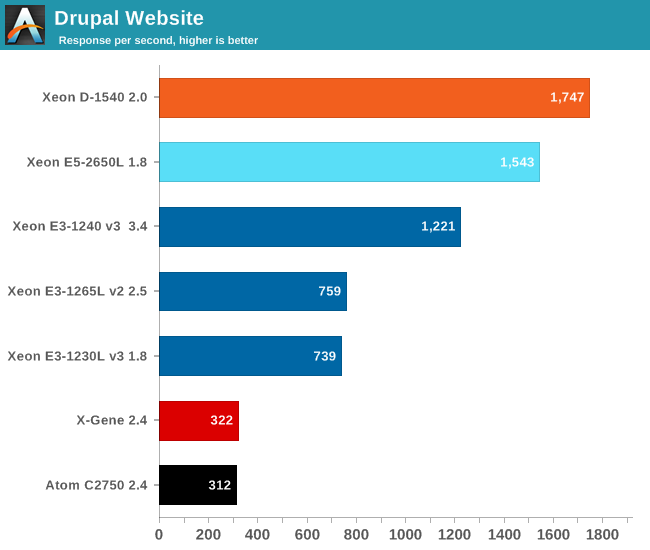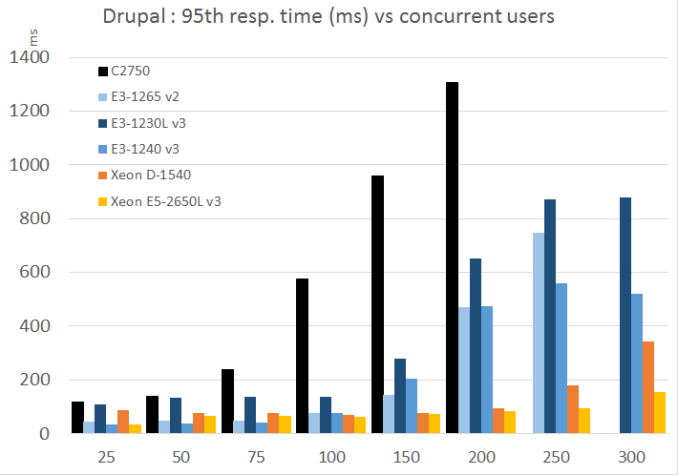The Intel Xeon D Review: Performance Per Watt Server SoC Champion?
by Johan De Gelas on June 23, 2015 8:35 AM EST- Posted in
- CPUs
- Intel
- Xeon-D
- Broadwell-DE
Web Server Performance
Websites based on the LAMP stack - Linux, Apache, MySQL, and PHP - are very popular. Few people write html/PHP code from scratch these days, so we turned to a Drupal 7.21 based site. The web server is Apache 2.4.7 and the database is MySQL 5.5.38 on top of Ubuntu 14.04 LTS.
Drupal powers massive sites (e.g. The Economist and MTV Europe) and has a reputation of being a hardware resource hog. That is a price more and more developers happily pay for lowering the time to market of their work. We tested the Drupal website with our vApus stress testing framework and increased the number of connections from 5 to 300.
We report the maximum throughput achievable with 95% percent of request being handled faster than 1000 ms.

Let us be honest: the graph above is not telling you everything. The truth is that, on the Xeon D and Xeon E5, we ran into several other bottlenecks (OS and Database related) before we ever could measure a 1000 ms 95th percentile response time. So the actual throughput at 1 second response time is higher.
Basically, the performance of the Xeon D and Xeon E5 was too high for our current benchmark setup. Let us zoom in a bit to get a more accurate picture. The picture below shows you the 95th percentile of the response time (Y-axis) versus the amount of concurrent requests/users (X-axis). We did not show the results of the Atom C2750 beyond 200 req/s to keep the graph readable.
We warm up the machine with 5 concurrent requests, but that is not enough for some servers. Notice that the response time of the Xeon D between 50 and 200 requests per second is lower than at 25 request per second. So let us start our analyses at 50 request per second.
The Xeon E3-1230L clock speed fluctuates between 1.8, 2.3 and 2.8 GHz. It is amazing low power chip, but you pay a price: the 95th percentile never goes below 100 ms. The highly clocked Xeon E3s like the 1240 keeps the response time below 100 ms unless your website is hit more than 100 times per second.
The Xeon D once again delivers astonishing performance. Unless the load is more than 200 concurrent requests per second, the server responds within 100 ms. There is more. Imagine that you want to keep your 95th percentile. response time below half a second. With a previous generation Xeon E3, even the 80W chip will hit that limit at around 200-250 requests per second. The Xeon D sustains about 800 (!) requests per second (not shown on graph) before a small percentage of the users will experience that response time. In other words, you can sustain up to 4 times as manyhits with the Xeon D-1540 compared to the E3.











90 Comments
View All Comments
Krysto - Tuesday, June 23, 2015 - link
Betteridge law.Metaluna - Tuesday, June 23, 2015 - link
...fails in this case. Did you read the review?CajunArson - Tuesday, June 23, 2015 - link
While desktop Broadwell isn't all that great, these server parts really show off Intel's accomplishments in improving power efficiency and performance-per-watt with 14nm.ARM has a huge hill to climb to really compete with these parts, and we've already seen AMD effectively skip its first iteration of an ARM product because they probably got wind of the Xeon D and decided they would have to do both a die-shrink and completely customized ARM core just to keep up.
The_Assimilator - Tuesday, June 23, 2015 - link
I very much doubt whether we'll ever see another server CPU from AMD, regardless of ARM cores or not. If they even manage to get Zen out the door, *and* it's not another massive flop, I will be impressed.Refuge - Tuesday, June 23, 2015 - link
I root for them everyday, but lets not give them too big of a hill to climb with a broken leg now. lolextide - Tuesday, June 23, 2015 - link
Take it easy man, AMD is not going down the drain any time soon, and we WILL see some future server oriented parts come from them. But how fast will they be? That's the question and we wont know for a while...Kjella - Tuesday, June 23, 2015 - link
Really? Last quarter they had a $187 million total comprehensive loss on $1030 million in revenue, even if you exclude the restructuring cost they lost $100 million for a -10% deficit. The stockholder's equity is almost gone with $17 million left, after that getting funding or a credit limit will become much harder.And Q2 is probably going to be another bloody quarter with no major CPU or GPU launches and firesales of old Win8 stock in preparation for Win10. The console ramp-up is usually in Q3 in preparation for Christmas, not before the summer. Last quarter's loss they took almost entirely from their cash reserves, they're now in the lower end of what they need to operate, if they lose this quarter too they must cut where it hurts bad.
Guspaz - Tuesday, June 23, 2015 - link
When we needed a low-power and low-cost server solution, we went with a desktop i3, because for some reason Intel supports ECC RAM on the i3 and lower, but not in the i5 and higher.julianb - Tuesday, June 23, 2015 - link
Very interested in this SOC.If possible could we see how the Xeon D deal with Cinebench Multithreaded test?
I am into 3D CPU rendering and would like to know how does the Xeon D-1540 compare to say i7-3930K or i7-4790K.
I realize the purpose of Xeon D-1540's existence is different but still...
Thank you.
MrSpadge - Saturday, June 27, 2015 - link
An eco-tuned 5820K seem better. I don't suppose you're going to render 24/7 all the time, so the electricity savings from the 14 nm Broadwell will have a hard time making up for the massive difference in initial cost.